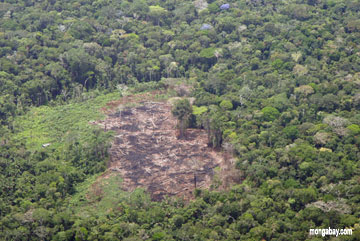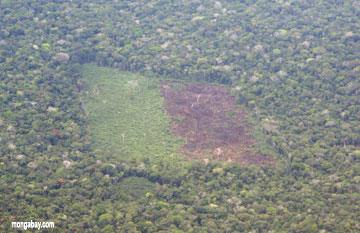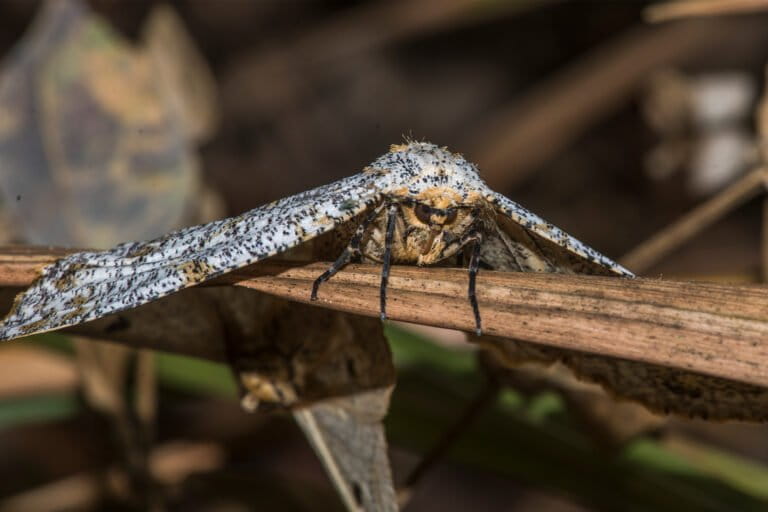Fires are nothing new to the Amazon reports a study published in the journal Biotropica.
Analyzing soils in the interior of Guyana, South America, a team of scientists led by David S. Hammond of NWFS Consulting, has found evidence of forest fires dating back thousands of years. While the origin of these fires is unclear, the authors propose intriguing scenarios involving pre-Colombian human populations and ancient el Niño events which could have so dried rainforest areas that they became more prone to forest fires.
“Ubiquitous charcoal from numerous sites indicates that closed canopy forests throughout the Guiana Shield region have been subject to fire events of unknown intensity over the last several millennia,” the authors wrote. “Pre-Colombian land-use, climate-induced drought, or a combination of these factors must be responsible.”
Were indigenous populations responsible for large-scale rainforest burning?
Noting that the incidence of fires appears to peak between 1000 and 1250 years before present — a time when indigenous populations are believed to be near their highest levels, Hammond told mongabay.com that “one scenario explaining the abundant charcoal from this period may be much greater human activity, and thus significantly larger native populations. With larger populations, a larger agrarian food system must be in place. Consequently, more forest would have been rotated through a process of clearing and burning.”

|
The authors note that while there is a lack of evidence of large pre-Colombian populations in Guyana, Hammond says that he wouldn’t expect to find any archeological remains given local conditions.
“Artifacts in the region would likely have been constructed from bone or wood — materials less likely to persist as evidence today,” he said. “Further, if one considers the difference in environmental pH conditions between the two regions [ Guyana versus Central America where stone Mayan ruins remain], it is even more apparent that many types of the more easily worked sedimentary stone, let alone bone or wood, would not persist in the Guiana Shield.”
“The absence of artifactual evidence at [these] sites is largely consistent with results from Nouragues and Manaus, although Amerindian settlement in these areas and at sites in the San Carlos and Porto Trombetas regions are well documented,” the authors wrote. “Most modern fires in the region are ultimately linked to human activity, indicating that pre-Colombian dwellers may also have started fires that then spread over larger areas of forest when fuel loads increased during significant dry down periods.”
ENSO’s role
Hammond, and his colleagues, Hans ter Steege and Klaas van der Borg of Utrecht University in The Netherlands, say that the eastern Amazon is particularly susceptible to drought during “anomalous phases of ENSO” (El-Nino Southern Oscillation). Drier conditions at these times would put forests at significant risk to burning. Research in South and Central America suggests that prolonged ENSO events could produce conditions where forest fires could become widespread without much human influence.
“Betty Meggars suggested in her 1994 paper in the journal Climatic Change that ENSO-driven drought over prolonged periods, the “mega El Niño” scenario, may have caused shifts in regional social systems,” explained Hammond. “Severe drought in the region is largely a consequence of anomalous sea-surface temperature movements along the Guiana coast. This is frequently, but not always, attached to west-east shifts in equatorial Pacific surface waters, the ENSO effect. Thus, extension of anomalous behavior could have led to more extensive dry-down periods across the regional forest landscape, and more widespread burning in the presence of only modest ignition sources.”
Collapse: a third possibility
While there is a possibility that fires could be entirely natural, Hammond says that forest-clearing human populations working in concert with an extended ENSO-driven drought could have an even greater impact.
“The third, and most dramatic scenario, the Mayan collapse’ theory, outlines a process of ramping population growth collapsing under the weight of constricting capacity to maintain itself during a prolonged period of low precipitation,” said Hammond via email. “It is noteworthy that the peak of charcoal formation in the Guiana Shield is consistent with archaeological evidence supporting the onset of collapse (750 AD, 1250 years ago) of the Mayan Classic period (250-950 AD, 1050 to 1750 years ago) (Haug et al. 2003).”

Deforestation in the Peruvian Amazon – photo by Rhett A. Butler. |
Hammond cautions that there is still insufficient evidence to conclude whether the third scenario could have occurred in the Guiana Shield, but says the work has present-day implications for the region.
“We ignore evidence of the past at our future peril. Managing tropical forests across the region without consideration of the catastrophic potential for fire-driven change during these periods can limit future prospects for sustainability and long-term conservation of the region’s rich catalogue of endemic plants and animals,” he warned.
“Modern tropical forests will continue to burn during El Niño drought events and as a consequence of spreading human populations (Hammond & ter Steege 1998). If the Maya collapsed under the weight of heightened ENSO-driven drought, it can happen again.”
RELATED ARTICLES
Indigenous populations deforested New World rainforests before European contact. Indigenous populations used fire to clear large areas of tropical forest well before the arrival of Europeans reports a new study published in Annals of the Missouri Botanical Garden. The research has important implications for understanding the impact of present forest development on biodiversity and forest regeneration in the tropics. Using pollen, phytolith, and charcoal records to identify the distribution and composition of tropical vegetation and fire patterns over the past 11,000 years, Dolores R. Piperno of the Smithsonian Tropical Research Institute in Panama and National Museum of Natural History in Washington, DC, found evidence of widespread fire use for land-clearing by pre-Colombian populations in Latin America. Her work confirms earlier research suggesting the substantial impact native populations had on tropical forests long before European arrival in the New World.
Pre-Colombian Amazon rainforest not heavily populated. Much of the Amazon rainforest was not heavily populated by pre-Colombian indigenous cultures argues a new paper published in the journal Philosophical Transactions of the Royal Society B: Biological Sciences. The work challenges an increasingly accepted theory — popularized in Charles C. Mann’s 1491: New Revelations of the Americas Before Columbus — that the Amazon supported dense, sedentary populations prior to the arrival of Europeans.
Amazon Stonehenge suggests advanced ancient rainforest culture. The discovery of an ancient astrological observatory in Brazil lends support to the theory that the Amazon rainforest was once home to advanced cultures and large sedentary populations of people. Besides the well-known empires of the Inca and their predecessors, millions of people once lived in the forests and shaped the environment to suit their own needs.
CITATION: Hammond, D.S., ter Steege, H., van der Borg, K. (2007). Upland Soil Charcoal in the Wet Tropical Forests of Central Guyana. BIOTROPICA 39(2): 153—160 2006. 10.1111/j.1744-7429.2006.00257.x















